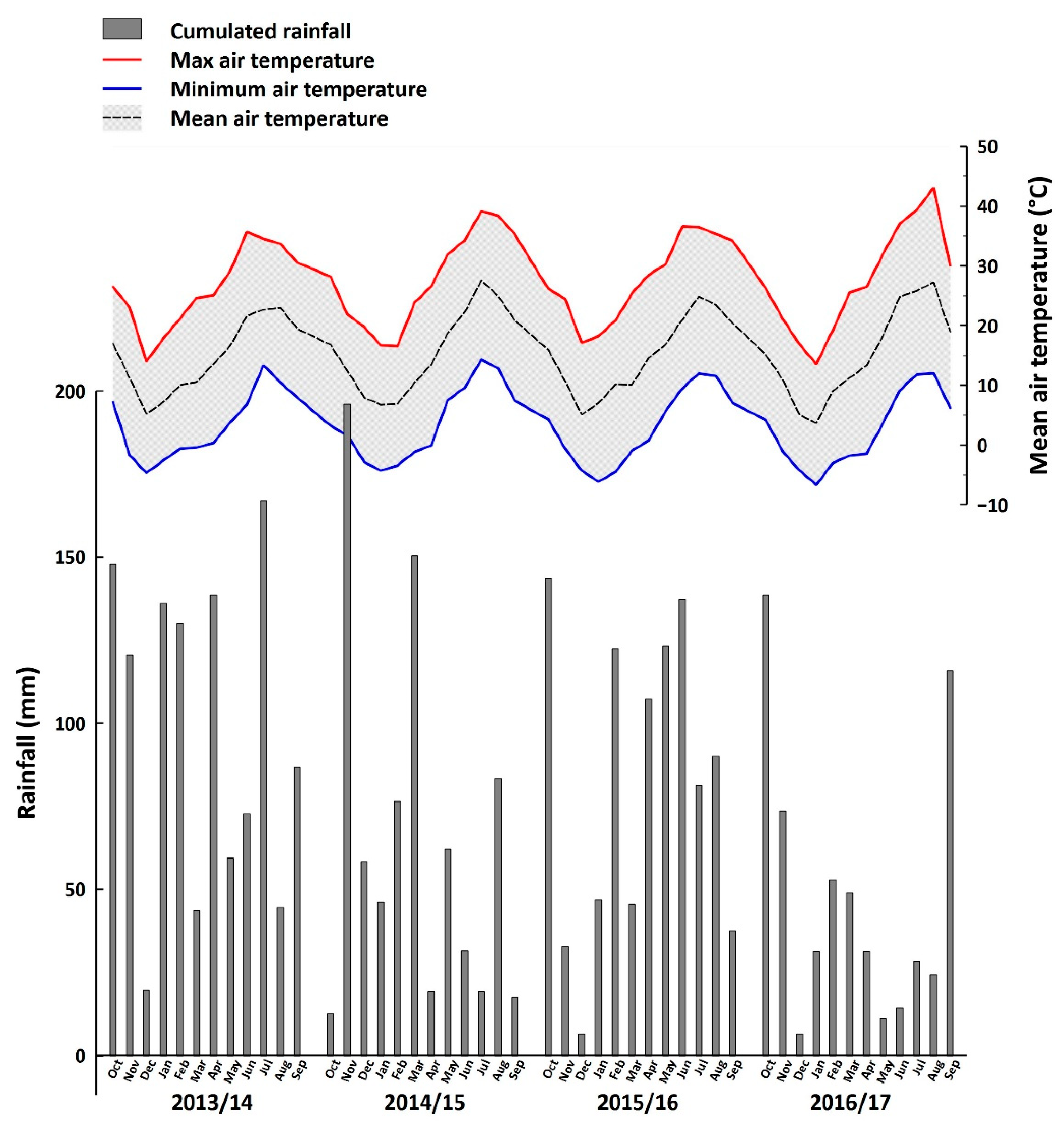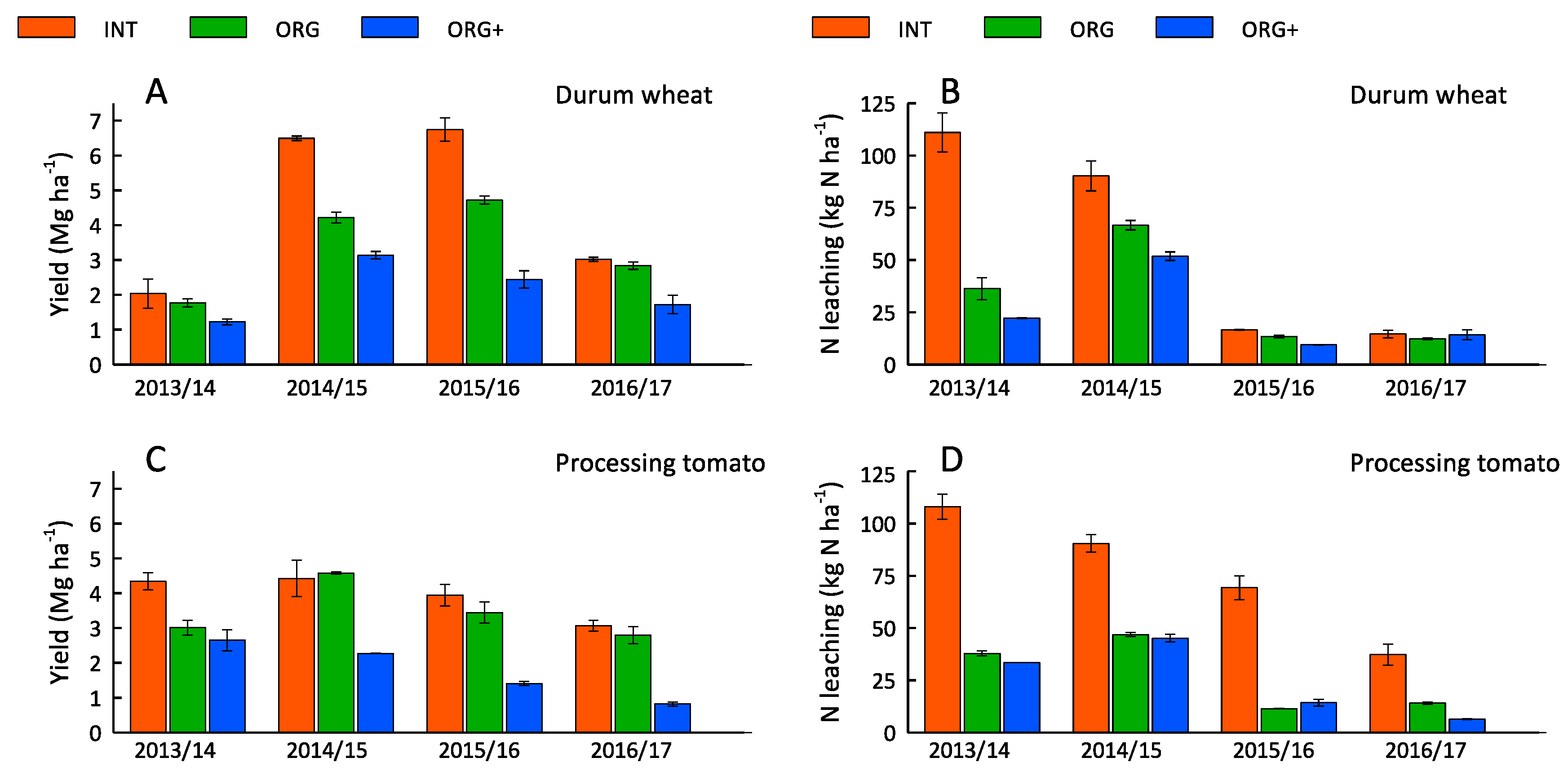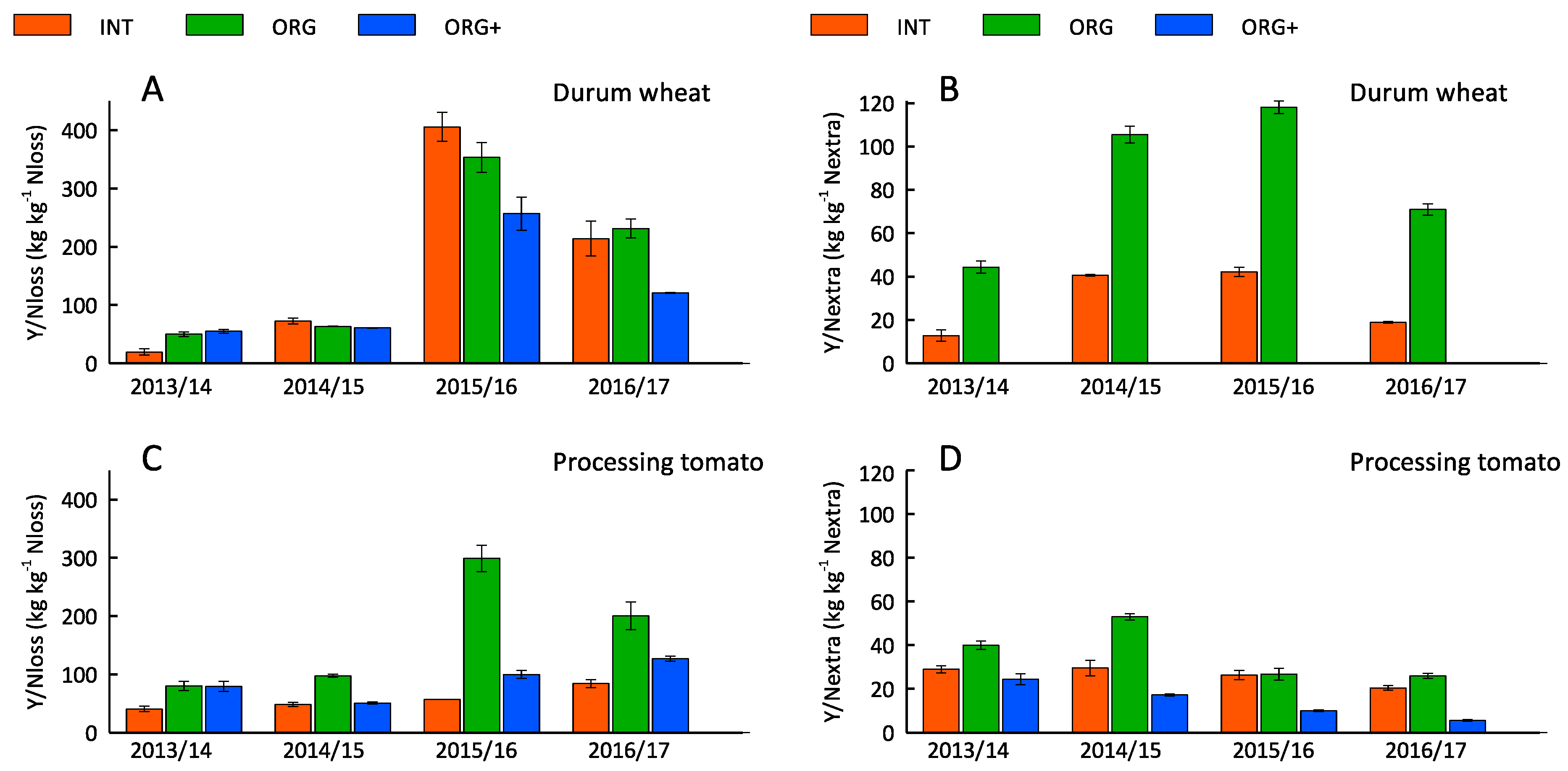Processing Tomato–Durum Wheat Rotation under Integrated, Organic and Mulch-Based No-Tillage Organic Systems: Yield, N Balance and N Loss
Abstract
1. Introduction
2. Materials and Methods
2.1. Experimental Site and Management of the Cropping Systems
2.1.1. Processing Tomato
2.1.2. Durum Wheat
2.2. Plant Sampling
2.3. NO3-N Leaching, N Balance and N Use Efficiency
2.4. Statistical Analysis
3. Results
3.1. Weather Conditions
3.2. N Balance
3.3. Yield and N Leaching
3.4. N Loss and Extra-Farm N Input Per Yield Unit
4. Discussion
5. Conclusions
Supplementary Materials
Author Contributions
Funding
Acknowledgments
Conflicts of Interest
References
- Cammarano, D.; Ceccarelli, S.; Grando, S.; Romagosa, I.; Benbelkacem, A.; Akar, T.; Al-Yassin, A.; Pecchioni, N.; Francia, E.; Ronga, D. The impact of climate change on barley yield in the Mediterranean basin. Eur. J. Agron. 2019, 106, 1–11. [Google Scholar] [CrossRef]
- Godfray, H.C.J.; Beddington, J.R.; Crute, I.R.; Haddad, L.; Lawrence, D.; Muir, J.F.; Pretty, J.; Robinson, S.; Thomas, S.M.; Toulmin, C. Food Security: The Challenge of Feeding 9 Billion People. Science 2010, 327, 812–818. [Google Scholar] [CrossRef] [PubMed]
- Bommarco, R.; Kleijn, D.; Potts, S.G. Ecological intensification: Harnessing ecosystem services for food security. Trends Ecol. Evol. 2013, 28, 230–238. [Google Scholar] [CrossRef] [PubMed]
- Duru, M.; Therond, O.; Martin, G.; Martin-Clouaire, R.; Magne, M.-A.; Justes, E.; Journet, E.-P.; Aubertot, J.-N.; Savary, S.; Bergez, J.-E.; et al. How to implement biodiversity-based agriculture to enhance ecosystem services: A review. Agron. Sustain. Dev. 2015, 35, 1259–1281. [Google Scholar] [CrossRef]
- García-González, I.; Hontoria, C.; Gabriel, J.L.; Alonso-Ayuso, M.; Quemada, M. Cover crops to mitigate soil degradation and enhance soil functionality in irrigated land. Geoderma 2018, 322, 81–88. [Google Scholar] [CrossRef]
- Benincasa, P.; Tosti, G.; Guiducci, M.; Farneselli, M.; Tei, F. Crop Rotation as a System Approach for Soil Fertility Management in Vegetables. In Advances in Research on Fertilization Management of Vegetable Crops; Advances in Olericulture; Springer: Cham, Switzerland, 2017; pp. 115–148. [Google Scholar] [CrossRef]
- Carlesi, S.; Bigongiali, F.; Antichi, D.; Ciaccia, C.; Tittarelli, F.; Canali, S.; Bàrberi, P. Green manure and phosphorus fertilization affect weed community composition and crop/weed competition in organic maize. Renew. Agr. Food Syst. 2019, 1–10. [Google Scholar] [CrossRef]
- Vincent-Caboud, L.; Casagrande, M.; David, C.; Ryan, M.R.; Silva, E.M.; Peigne, J. Using mulch from cover crops to facilitate organic no-till soybean and maize production. A review. Agron. Sustain. Dev. 2019, 39, 45. [Google Scholar] [CrossRef]
- Henneron, L.; Bernard, L.; Hedde, M.; Pelosi, C.; Villenave, C.; Chenu, C.; Bertrand, M.; Girardin, C.; Blanchart, E. Fourteen years of evidence for positive effects of conservation agriculture and organic farming on soil life. Agron. Sustain. Dev. 2015, 35, 169–181. [Google Scholar] [CrossRef]
- Teasdale, J.R.; Coffman, C.B.; Mangum, R.W. Potential Long-Term Benefits of No-Tillage and Organic Cropping Systems for Grain Production and Soil Improvement. Agron. J. 2007, 99, 1297–1305. [Google Scholar] [CrossRef]
- Peigné, J.; Vian, J.-F.; Payet, V.; Saby, N.P.A. Soil fertility after 10 years of conservation tillage in organic farming. Soil Till. Res. 2018, 175, 194–204. [Google Scholar] [CrossRef]
- Bosco, S.; Volpi, I.; Antichi, D.; Ragaglini, G.; Frasconi, C. Greenhouse Gas Emissions from Soil Cultivated with Vegetables in Crop Rotation under Integrated, Organic and Organic Conservation Management in a Mediterranean Environment. Agronomy 2019, 9, 446. [Google Scholar] [CrossRef]
- Casagrande, M.; Peigné, J.; Payet, V.; Mäder, P.; Sans, F.X.; Blanco-Moreno, J.M.; Antichi, D.; Bàrberi, P.; Beeckman, A.; Bigongiali, F.; et al. Organic farmers’ motivations and challenges for adopting conservation agriculture in Europe. Org. Agric. 2016, 6, 281–295. [Google Scholar] [CrossRef]
- Vincent-Caboud, L.; Peigné, J.; Casagrande, M.; Silva, E.M. Overview of Organic Cover Crop-Based No-Tillage Technique in Europe: Farmers’ Practices and Research Challenges. Agriculture 2017, 7, 42. [Google Scholar] [CrossRef]
- Kubota, H.; Iqbal, M.; Quideau, S.; Dyck, M.; Spaner, D. Agronomic and physiological aspects of nitrogen use efficiency in conventional and organic cereal-based production systems. Renew. Agr. Food Syst. 2018, 33, 443–466. [Google Scholar] [CrossRef]
- De Notaris, C.; Rasmussen, J.; Sørensen, P.; Olesen, J.E. Nitrogen leaching: A crop rotation perspective on the effect of N surplus, field management and use of catch crops. Agric. Ecosyst. Environ. 2018, 255, 1–11. [Google Scholar] [CrossRef]
- Farneselli, M.; Tosti, G.; Onofri, A.; Benincasa, P.; Guiducci, M.; Pannacci, E.; Tei, F. Effects of N sources and management strategies on crop growth, yield and potential N leaching in processing tomato. Eur. J. Agron. 2018, 98, 46–54. [Google Scholar] [CrossRef]
- Montemurro, F.; Fiore, A.; Campanelli, G.; Tittarelli, F.; Ledda, L.; Canali, S. Organic Fertilization, Green Manure, and Vetch Mulch to Improve Organic Zucchini Yield and Quality. HortScience 2013, 48, 1027–1033. [Google Scholar] [CrossRef]
- Guiducci, M.; Tosti, G.; Falcinelli, B.; Benincasa, P. Sustainable management of nitrogen nutrition in winter wheat through temporary intercropping with legumes. Agron. Sustain. Dev. 2018, 38, 31. [Google Scholar] [CrossRef]
- Isaac, R.A.; Johnson, W.C. Determination of total nitrogen in plant tissue, using a block digestor. J. Assoc. Off. Anal. Chem. 1976, 59, 98–100. [Google Scholar]
- Curley, E.M.; O’Flynn, M.G.; McDonnell, K.P. Porous Ceramic Cups: Preparation and Installation of Samplers for Measuring Nitrate Leaching. Int. J. Soil Sci. 2010, 5, 19–25. [Google Scholar] [CrossRef][Green Version]
- Tosti, G.; Farneselli, M.; Benincasa, P.; Guiducci, M. Nitrogen Fertilization Strategies for Organic Wheat Production: Crop Yield and Nitrate Leaching. Agron. J. 2016, 108, 1–12. [Google Scholar] [CrossRef]
- Gabriel, J.L.; Munoz-Carpena, R.; Quemada, M. The role of cover crops in irrigated systems: Water balance, nitrate leaching and soil mineral nitrogen accumulation. Agric. Ecosyst. Environ. 2012, 155, 50–61. [Google Scholar] [CrossRef]
- Ferretti, M.; Marchetto, A.; Arisci, S.; Bussotti, F.; Calderisi, M.; Carnicelli, S.; Cecchini, G.; Fabbio, G.; Bertini, G.; Matteucci, G.; et al. On the tracks of Nitrogen deposition effects on temperate forests at their southern European range—An observational study from Italy. Glob. Chang. Biol. 2014, 20, 3423–3438. [Google Scholar] [CrossRef] [PubMed]
- Antichi, D. Effect of Intercropping on Yield and Quality of Organic Durum Wheat. Ph.D Thesis, University of Pisa, Pisa, Italy, 2013. Available online: http://etd.adm.unipi.it/ (accessed on 3 October 2019).
- Saia, S.; Urso, V.; Amato, G.; Frenda, A.S.; Giambalvo, D.; Ruisi, P.; Miceli, G.D. Mediterranean forage legumes grown alone or in mixture with annual ryegrass: Biomass production, N2 fixation, and indices of intercrop efficiency. Plant Soil 2016, 402, 395–407. [Google Scholar] [CrossRef]
- Onofri, A.; Seddaiu, G.; Piepho, H.-P. Long-Term Experiments with cropping systems: Case studies on data analysis. Eur. J. Agron. 2016, 77, 223–235. [Google Scholar] [CrossRef]
- Bretz, F.; Hothorn, T.; Westfall, P.; Hothorn, T.; Westfall, P. Multiple Comparisons Using R; Chapman and Hall: New York, NY, USA, 2016. [Google Scholar] [CrossRef]
- R Core Team. R: A Language and Environment for Statistical Computing; R Foundation for Statistical Computing: Vienna, Austria, 2018. Available online: https://www.R.-project.org/ (accessed on 22 October 2019).
- Jan, P.; Calabrese, C.; Lips, M. Determinants of nitrogen surplus at farm level in Swiss agriculture. Nutr. Cycl. Agroecosyst. 2017, 109, 133–148. [Google Scholar] [CrossRef]
- Iannetta, P.P.M.; Young, M.; Bachinger, J.; Bergkvist, G.; Doltra, J.; Lopez-Bellido, R.J.; Monti, M.; Pappa, V.A.; Reckling, M.; Topp, C.F.E.; et al. A comparative nitrogen balance and productivity analysis of legume and non-legume supported cropping systems: The potential role of biological nitrogen fixation. Front. Plant Sci. 2016, 7. [Google Scholar] [CrossRef]
- Schrama, M.; de Haan, J.J.; Kroonen, M.; Verstegen, H.; Van der Putten, W.H. Crop yield gap and stability in organic and conventional farming systems. Agric. Ecosyst. Environ. 2018, 256, 123–130. [Google Scholar] [CrossRef]
- Knapp, S.; van der Heijden, M.G.A. A global meta-analysis of yield stability in organic and conservation agriculture. Nat. Commun. 2018, 9, 3632. [Google Scholar] [CrossRef]
- Cooper, J.; Baranski, M.; Stewart, G.; Nobel-de Lange, M.; Bàrberi, P.; Fließbach, A.; Peigné, J.; Berner, A.; Brock, C.; Casagrande, M.; et al. Shallow non-inversion tillage in organic farming maintains crop yields and increases soil C stocks: A meta-analysis. Agron. Sustain. Dev. 2016, 36, 22. [Google Scholar] [CrossRef]
- Reckling, M.; Hecker, J.-M.; Bergkvist, G.; Watson, C.A.; Zander, P.; Schläfke, N.; Stoddard, F.L.; Eory, V.; Topp, C.F.E.; Maire, J.; et al. A cropping system assessment framework—Evaluating effects of introducing legumes into crop rotations. Eur. J. Agron. 2016. [Google Scholar] [CrossRef]
- Blanco-Canqui, H.; Ruis, S.J. No-tillage and soil physical environment. Geoderma 2018, 326, 164–200. [Google Scholar] [CrossRef]
- Marinari, S.; Mancinelli, R.; Brunetti, P.; Campiglia, E. Soil quality, microbial functions and tomato yield under cover crop mulching in the Mediterranean environment. Soil Till. Res. 2015, 145, 20–28. [Google Scholar] [CrossRef]
- Alluvione, F.; Fiorentino, N.; Bertora, C.; Zavattaro, L.; Fagnano, M.; Chiaranda, F.Q.; Grignani, C. Short-term crop and soil response to C-friendly strategies in two contrasting environments. Eur. J. Agron. 2013, 45, 114–123. [Google Scholar] [CrossRef]
- Farneselli, M.; Benincasa, P.; Tosti, G.; Pace, R.; Tei, F.; Guiducci, M. Nine-year results on maize and processing tomato cultivation in an organic and in a conventional low input cropping system. Ital. J. Agron. 2013, 8, e2. [Google Scholar] [CrossRef]
- Tosti, G.; Benincasa, P.; Farneselli, M.; Tei, F.; Guiducci, M. Barley-hairy vetch mixture as cover crop for green manuring and the mitigation of N leaching risk. Eur. J. Agron. 2014, 54, 34–39. [Google Scholar] [CrossRef]
- Drinkwater, L.E.; Snapp, S.S. Nutrients in Agroecosystems: Rethinking the Management Paradigm. In Advances in Agronomy; Sparks, D.L., Ed.; Academic Press: Cambridge, MA, USA, 2007; Volume 92, pp. 163–186. ISBN 9780080457420. [Google Scholar]
- Connor, D.J. Organic agriculture cannot feed the world. Field Crop. Res. 2008, 106, 187–190. [Google Scholar] [CrossRef]
- Wilbois, K.-P.; Schmidt, J.E. Reframing the Debate Surrounding the Yield Gap between Organic and Conventional Farming. Agronomy 2019, 9, 82. [Google Scholar] [CrossRef]
- Wittwer, R.A.; Dorn, B.; Jossi, W.; van der Heijden, M.G.A. Cover crops support ecological intensification of arable cropping systems. Sci. Rep. 2017, 7, 41911. [Google Scholar] [CrossRef]
- Dal Ferro, N.; Zanin, G.; Borin, M. Crop yield and energy use in organic and conventional farming: A case study in north-east Italy. Eur. J. Agron. 2017, 86, 37–47. [Google Scholar] [CrossRef]



| INT | ORG | ORG+ | ||||
|---|---|---|---|---|---|---|
| Ninput | ||||||
| Fertilizers | 155.0 | a | 69.8 | b | 66.2 | b |
| Ndfa | 0.0 | - | 25.2 | b | 34.2 | a |
| Seeds | 2.0 | c | 4.2 | b | 11.5 | a |
| Deposition | 5.0 | a | 5.0 | a | 5.0 | a |
| Total Ninput | 162.0 | a | 104.2 | c | 116.8 | b |
| Noutput | 104.0 | a | 75.7 | b | 44.0 | c |
| Nsurplus | 58.1 | a | 28.6 | b | 72.8 | a |
| Nleaching | 67.2 | a | 29.9 | b | 24.7 | b |
© 2019 by the authors. Licensee MDPI, Basel, Switzerland. This article is an open access article distributed under the terms and conditions of the Creative Commons Attribution (CC BY) license (http://creativecommons.org/licenses/by/4.0/).
Share and Cite
Tosti, G.; Benincasa, P.; Farneselli, M.; Guiducci, M.; Onofri, A.; Tei, F. Processing Tomato–Durum Wheat Rotation under Integrated, Organic and Mulch-Based No-Tillage Organic Systems: Yield, N Balance and N Loss. Agronomy 2019, 9, 718. https://doi.org/10.3390/agronomy9110718
Tosti G, Benincasa P, Farneselli M, Guiducci M, Onofri A, Tei F. Processing Tomato–Durum Wheat Rotation under Integrated, Organic and Mulch-Based No-Tillage Organic Systems: Yield, N Balance and N Loss. Agronomy. 2019; 9(11):718. https://doi.org/10.3390/agronomy9110718
Chicago/Turabian StyleTosti, Giacomo, Paolo Benincasa, Michela Farneselli, Marcello Guiducci, Andrea Onofri, and Francesco Tei. 2019. "Processing Tomato–Durum Wheat Rotation under Integrated, Organic and Mulch-Based No-Tillage Organic Systems: Yield, N Balance and N Loss" Agronomy 9, no. 11: 718. https://doi.org/10.3390/agronomy9110718
APA StyleTosti, G., Benincasa, P., Farneselli, M., Guiducci, M., Onofri, A., & Tei, F. (2019). Processing Tomato–Durum Wheat Rotation under Integrated, Organic and Mulch-Based No-Tillage Organic Systems: Yield, N Balance and N Loss. Agronomy, 9(11), 718. https://doi.org/10.3390/agronomy9110718





